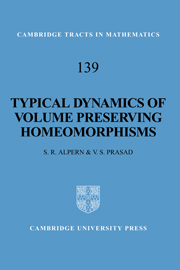Book contents
- Frontmatter
- Contents
- Historical Preface
- General Outline
- Part I Volume Preserving Homeomorphisms of the Cube
- 1 Introduction to Parts I and II (Compact Manifolds)
- 2 Measure Preserving Homeomorphisms
- 3 Discrete Approximations
- 4 Transitive Homeomorphisms of In and Rn
- 5 Fixed Points and Area Preservation
- 6 Measure Preserving Lusin Theorem
- 7 Ergodic Homeomorphisms
- 8 Uniform Approximation in G[In, λ] and Generic Properties in M[In, λ]
- Part II Measure Preserving Homeomorphisms of a Compact Manifold
- Part III Measure Preserving Homeomorphisms of a Noncompact Manifold
- Appendix 1 Multiple Rokhlin Towers and Conjugacy Approximation
- Appendix 2 Homeomorphic Measures
- Bibliography
- Index
1 - Introduction to Parts I and II (Compact Manifolds)
Published online by Cambridge University Press: 24 August 2009
- Frontmatter
- Contents
- Historical Preface
- General Outline
- Part I Volume Preserving Homeomorphisms of the Cube
- 1 Introduction to Parts I and II (Compact Manifolds)
- 2 Measure Preserving Homeomorphisms
- 3 Discrete Approximations
- 4 Transitive Homeomorphisms of In and Rn
- 5 Fixed Points and Area Preservation
- 6 Measure Preserving Lusin Theorem
- 7 Ergodic Homeomorphisms
- 8 Uniform Approximation in G[In, λ] and Generic Properties in M[In, λ]
- Part II Measure Preserving Homeomorphisms of a Compact Manifold
- Part III Measure Preserving Homeomorphisms of a Noncompact Manifold
- Appendix 1 Multiple Rokhlin Towers and Conjugacy Approximation
- Appendix 2 Homeomorphic Measures
- Bibliography
- Index
Summary
Dynamics on Compact Manifolds
Two of the principal analytic structures that may be put on a set X are measure and topology. We are interested in transformations of X which preserve both of these structures: measure preserving homeomorphisms. In the first half of the book, Parts I and II, the topological space X will be a compact manifold, possibly with boundary. (In fact Part I specializes to the case where X is simply the unit cube In in some dimension n ≥ 2.) The measure, denoted µ, will be a nonatomic Borel probability measure which assigns the manifold boundary measure zero and is positive on all nonempty open sets (a property we call locally positive). (In Part I, µ is simply the volume measure on the cube.) The first two parts of the book are concerned with determining typical properties of µ-preserving homeomorphisms of the (arbitrary) compact manifold X. We denote the set of all such homeomorphisms by M[X, µ], which we endow with the uniform topology, with respect to which it is complete. We call a property typical, or generic, if it is possessed by a dense Gδ (or larger) subset of transformations. The purpose of this introductory chapter is to give a nontechnical presentation of the main results, and the definitions they involve, for measure preserving homeomorphisms of compact manifolds. Both the definitions and theorems mentioned in this chapter will be presented more rigorously in later chapters.
- Type
- Chapter
- Information
- Publisher: Cambridge University PressPrint publication year: 2001



